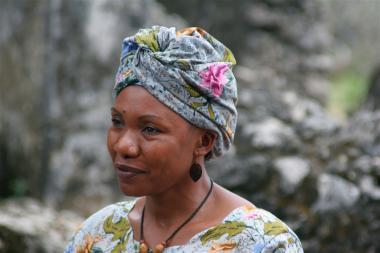My father spent 45 years living and working in East Africa. During the first 15 years he worked with the Sukuma people in northern Tanganyika. The Sukuma people are the largest ethnic groups in Tanzania and they live in the plains just south of Lake Victoria. My father learned their language and culture and was intrigued by their ceremonies and the parallels with Christianity. He used some of these rituals as parables in his sermons. The following ritual is called Kupalanghanya.
About 70 years ago a young Sukuma man decided he was old enough to marry. He went and asked his father to arrange for a wife and his father agreed. His father was able to locate a beautiful girl from a prominent family and the marriage was arranged after a great deal of discussion between the two families. After the marriage celebration Maswa took his wife to a fertile valley where he built a mud house with a fine grass roof. Around the house he drew a large circle and then planted prickly pear and euphorbia bushes. Eventually these plants grew up into a strong fence that was virtually impenetrable. The purpose of the fence was to keep the cattle in at night and the predators out. But there was also a second, even more important reason. Evil spirits and witches were always a danger and it was a well-known theory that they were afraid of thorns. Maswa also built a strong gate that led in and out of his compound and this was firmly barricaded at night.
As time went on Maswa became prosperous. His herds of cattle increased and he had a number of children. He later took a second wife and his compound was composed of a number of houses and many of his extended family – all living inside the thorn fence. One of his favorite children was a daughter named Gawiza who was growing up to be a beautiful young woman. Maswa kept a close eye on her since chastity was an important value among the Sukuma people and the young men were beginning to take an active interest in Gawiza. One night during the full moon there was a big dance and Gawiza was enamored with a young man who was a superb dancer. Later after the dance she crept out of her house and met the young man in the forest.
A few months later the evidence of her midnight tryst began to show. When her father Maswa found out about her pregnancy, he was infuriated. His daughter Gawiza had brought shame to his household. He seized Gawiza by the arm and dragged her through the gate and out of the compound. With angry words and gestures he disowned her and sent her away. He swore an oath that as long as he lived she could never again pass through the gate and enter the family compound.
Gawiza left her home with a heavy heart. After a few day of wandering she found some poor people who were willing to let her work for a few scraps of food. She was not well treated and was looked down upon because of her pregnancy. Eventually her time to deliver came due and she bore a son. Her son was a joy to her, but her living situation continued to be very difficult. She finally decided to return home to her family and see if they would forgive her and accept her son.
She tied her new baby on her back and after a long walk arrived at the gate of her father’s compound. She did not enter, but called out and eventually her father and other members of her family came out to greet her. She asked for forgiveness for her sin and pleaded to be allowed back into the family. Maswa thought about it and finally decided that he would like to have her come back and be part of the family. However, he had made a vow that she could never again enter the gate of his compound and he could not break that vow. But he did know a way that she could be reinstated with the family. He decided to hold a special ceremony called Kupalanghanya.
Maswa told his wife bring some milk for Gawiza to drink and had her sit in the shade of a tree outside the compound. Then he went into his house and got his panga (long machete). Going to the hedge at the back of his compound he began cutting away at the dense thicket of prickly pear and euphorbia bushes. It was difficult work with the thorns piercing his arms and the white sap of the euphorbia burning his skin. As he cut the branches he dragged them to the original gate and stacked them so that the gate was completely sealed. Meanwhile he continued making a new gate at the rear of the compound. After much hard work the old man finally hacked through the hedge and opened a new entrance. Maswa then went to the goat corral and selected a white lamb. He took the lamb to the new gate and there he took his knife and cut its throat so that the blood was spilled on the ground. Gawiza was called and she entered the compound through the new gate – walking on the blood of the lamb that had died to forgive her sin. Because of her father’s vow there had been no way she could enter her home through the old gate, but he had opened a new gate. That night the sacrificial lamb was cooked and eaten by all members of the household – a feast that symbolized that Gawiza was once more part of the family.
To purchase Jon Arensen’s books click HERE


Recent Comments